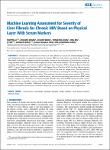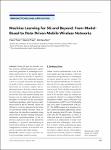BBAuthors: Li, N.; Advisor: -; Participants: Zhang, J.; Wang, S.; Jiang, Y.; Ma, J.; Dong, L.; Gong, G. (2019)
Noninvasive assessment of severity of liver brosis is crucial for understanding histology and making decisions on antiviral treatment for chronic HBV in view of the associated risks of biopsy. We aimed to develop a computer-assisted assessment system for the evaluation of liver disease severity by using machine leaning classi er based on physical-layer with serum markers. The retrospective data set, including 920 patients, was used to establish Decision Tree Classi er (DTC), Random Forest Classi er (RFC), Logistic Regression Classi er (LRC), and Support Vector Classi er (SVC) for liver brosis severity assessment. Training and testing samples account for 50% of the data set, respectively. The best indicator combinations were selected in random combinations of 24 indicators includin... 

